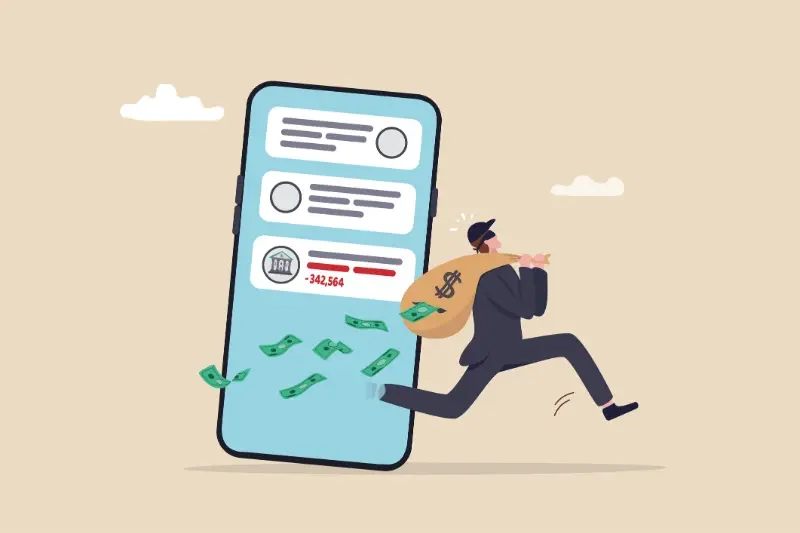API Security Vulnerabilities That Break Mobile Platforms
A popular fitness app suddenly stops working for millions of users worldwide. The culprit? Hackers exploited a weakness in the app's API security, gaining access to personal health data, workout routines, and location information. Within hours, user data was being sold on the dark web whilst the company scrambled to fix the breach—but the damage was already done.
This scenario plays out more often than you might think, and it's exactly why API security has become one of the biggest headaches for mobile app developers today. APIs (Application Programming Interfaces) are the invisible bridges that let your mobile apps talk to servers, databases, and other services. They're working behind the scenes every time you check the weather, send a message, or update your social media status.
The weakest link in mobile platform security isn't usually the app itself—it's how that app communicates with the outside world through APIs.
Here's what makes this particularly tricky: mobile platforms present unique security challenges that traditional web applications simply don't face. Your app might be running on an Android phone in Manchester one minute and an iPhone in Sydney the next, each with different network conditions, security settings, and potential vulnerabilities. When APIs aren't properly protected, they become open doors for cybercriminals looking to steal user data, compromise systems, or worse—completely break your development platform. Understanding these vulnerabilities isn't just technical knowledge; it's business survival in today's mobile-first world.
What Are APIs and Why Do They Matter
APIs might sound like technical jargon, but they're actually quite simple once you break them down. Think of an API—or Application Programming Interface—as a messenger between different pieces of software. When you open your favourite weather app, it doesn't store all the weather data itself; instead, it sends a request through an API to get the latest information from a weather service.
Every time you log into an app using your Google account, share a photo on social media, or make a payment through your phone, APIs are working behind the scenes. They're the invisible connections that make modern mobile apps work properly. Without them, every app would need to build every single feature from scratch—which would be incredibly expensive and time-consuming.
Why Mobile Apps Depend on APIs
Mobile apps use APIs for almost everything these days. Payment processing, user authentication, social media sharing, location services, push notifications—the list goes on. Your banking app uses APIs to check your balance; your food delivery app uses them to track your order; your fitness app uses them to sync with your smartwatch.
This dependency makes APIs both incredibly useful and potentially dangerous. When an API works well, everything runs smoothly. But when security isn't handled properly, these same connections become entry points for hackers. That's exactly why API security matters so much—they're not just technical components, they're the foundations that keep your personal data safe while you use your favourite apps.
Common Security Flaws That Expose Your Data
When I look at mobile apps that have been hacked, there's usually a pattern. The same API security vulnerabilities keep appearing again and again. It's like watching the same film over and over—you know exactly what's coming next, but somehow developers keep making these mistakes.
The biggest problem I see is broken object level authorisation. This happens when your mobile app can access data it shouldn't be able to touch. Let's say your app requests user profile information from an API. If the API doesn't check properly, your app might accidentally receive someone else's personal details instead of just your own. That's a massive data leak waiting to happen.
The Most Dangerous Security Gaps
Here are the security flaws that cause the most damage to mobile platforms:
- Broken authentication that lets anyone pretend to be a legitimate user
- Excessive data exposure where APIs send too much sensitive information
- Lack of resources and rate limiting that allows attackers to overwhelm your system
- Poor logging and monitoring that means you don't know when you're under attack
- Improper asset management where old, vulnerable API versions stay online
Always test your APIs by trying to access data you shouldn't be able to reach. If you can see other users' information, so can hackers.
What makes these flaws so dangerous is how they compound each other. Poor authentication combined with excessive data exposure creates a perfect storm for data breaches. Your development platform might be secure, but if your API protection isn't up to scratch, you're leaving the back door wide open. The good news? Most of these problems are fixable once you know what to look for.
Authentication Failures That Leave Doors Open
Authentication is basically your app's way of checking someone is who they say they are—like showing your passport at the airport. When this process breaks down in mobile apps, it creates massive security holes that hackers love to exploit.
The most common problem I see is weak password requirements. Apps that allow "password123" or "admin" as valid passwords are asking for trouble. But it goes deeper than that; many apps don't properly verify user credentials on the server side, trusting whatever the mobile app tells them.
Session Management Gone Wrong
Once someone logs in, your app creates a session—think of it as a temporary pass that says "this person is allowed in." The problem comes when these sessions never expire or when they're stored insecurely on the device. I've seen apps where sessions last forever, meaning if someone steals your phone, they have permanent access to your accounts.
Multi-factor authentication sounds complicated, but it's just adding an extra step (like texting you a code). Many apps skip this completely, making it ridiculously easy for attackers who've guessed or stolen passwords.
Common Authentication Vulnerabilities
- Passwords transmitted without encryption
- No account lockout after failed login attempts
- Sessions that don't expire properly
- Weak password reset processes
- Missing two-factor authentication
- Poor credential storage on devices
The scary part? Many developers assume their authentication is working fine because login seems to work. But working and being secure are two very different things. A properly secured authentication system should make it incredibly difficult for unauthorised users to gain access, even if they have some of your information.
Data Transmission Problems Mobile Apps Face
When your mobile app sends information back and forth between your phone and a server, that data needs protection during its journey. Think of it like sending a postcard through the mail—anyone along the way could potentially read what's written on it unless you put it in a sealed envelope first.
The biggest problem we see with mobile platform security is apps that don't encrypt their data properly during transmission. This means sensitive information like passwords, personal details, or payment information travels across the internet in plain text. Anyone monitoring network traffic can intercept and read this data; it's like having a conversation in a crowded room where everyone can hear your secrets.
Man-in-the-Middle Attacks
These attacks happen when someone positions themselves between your app and the server, pretending to be the legitimate destination. Your app thinks it's talking to the real server, but it's actually sending all its data to an attacker. Public WiFi networks are particularly dangerous for this—that free internet at the coffee shop might not be as safe as you think.
Data encryption during transmission isn't optional anymore; it's the minimum standard users should expect from any professional mobile application
Certificate Validation Issues
Many apps skip proper certificate checking, which is like not verifying someone's identity before handing over confidential documents. SSL certificates prove that the server you're connecting to is legitimate, but some developers disable these checks to make development easier and forget to turn them back on for the live app. This leaves users completely exposed to API security vulnerabilities that could have been prevented with proper development platform practices.
Real Consequences of Poor API Protection
When API security fails, the results aren't just numbers on a report—they hit businesses where it hurts most. I've watched companies struggle with the fallout from breaches that could have been prevented with proper protection. The damage goes far beyond fixing code.
Financial losses top the list of consequences. Data breaches can cost millions in fines, legal fees, and compensation payments. Companies often face regulatory penalties that drain resources for months or years. But that's just the beginning—the hidden costs of rebuilding systems, hiring security experts, and managing crisis communications add up quickly.
Trust Takes Years to Rebuild
Customer trust disappears overnight when personal data gets stolen. Users delete apps, cancel subscriptions, and warn others to stay away. Social media amplifies negative experiences faster than companies can respond. Winning back that trust requires years of consistent security practices and transparent communication.
Business Operations Suffer
Poor API security creates operational nightmares that affect daily business. Systems crash under attack, customer support teams get overwhelmed with complaints, and development work stops whilst teams fix vulnerabilities. Revenue streams dry up when apps go offline or users lose confidence in the platform.
The most damaging consequence might be reputational harm. News of security breaches spreads quickly through industry networks and media coverage. Potential customers research companies before downloading apps—negative security headlines appear in search results for years. This lasting damage affects future growth, partnership opportunities, and investor confidence long after the initial breach gets resolved.
- Regulatory fines and legal costs
- Loss of customer trust and user base
- Operational disruption and downtime
- Long-term reputational damage
- Increased insurance premiums
- Competitive disadvantage in the market
Best Practices for Stronger Mobile Security
Right, let's talk about what actually works when it comes to keeping your mobile platform security tight. I've seen too many developers think they can bolt on security as an afterthought—spoiler alert: you can't. API security needs to be baked into your development process from day one, not something you remember when you're about to launch.
The foundation of solid API protection starts with proper authentication and authorisation. Use OAuth 2.0 or similar industry standards rather than rolling your own solution. Trust me on this one—custom authentication systems are where security vulnerabilities love to hide. You'll also want to implement token-based authentication with reasonable expiry times; don't let tokens live forever just because it's convenient.
Data Protection Techniques
Encryption isn't optional anymore. All data transmission between your mobile app and APIs must use HTTPS with TLS 1.2 or higher. But here's what many miss—encrypt sensitive data at rest too. Your API endpoints should validate every single request, checking not just what data is being requested but whether the user has permission to access it.
- Implement rate limiting to prevent API abuse
- Use API gateways to centralise security policies
- Regularly update and patch all security dependencies
- Monitor API traffic for unusual patterns
- Implement proper error handling that doesn't leak information
Never expose internal system details in API error messages—attackers use this information to map out your infrastructure and find weak spots.
Testing your security measures regularly is non-negotiable. Run penetration tests, conduct code reviews focusing on security, and keep your development platform updated. Security isn't a destination—it's an ongoing process that needs constant attention.
Conclusion
API security vulnerabilities are real threats that can destroy mobile platforms overnight. They're not just technical problems that developers need to worry about—they affect every business that relies on mobile apps to connect with customers. From broken authentication systems to poorly encrypted data transmission, these flaws create entry points for attackers who want to steal information, disrupt services, or damage your reputation.
What makes this particularly challenging is that many organisations don't realise their APIs are vulnerable until it's too late. The damage spreads quickly once attackers find a weakness. Customer data gets compromised, business operations stop working, and trust disappears faster than you can fix the problem. We've seen companies lose millions in revenue and spend years rebuilding their reputation after a single security breach.
The good news is that most API security vulnerabilities can be prevented with proper planning and implementation. Strong authentication methods, encrypted data transmission, regular security testing, and comprehensive monitoring systems create multiple layers of protection. These aren't expensive solutions that only big companies can afford—they're standard practices that every mobile app should follow from day one.
Building secure APIs isn't something you can add later as an afterthought. Security needs to be part of the design process from the beginning. When you're planning your next mobile app or reviewing your existing systems, make API security a priority. Your users trust you with their data, and protecting that trust should be at the heart of everything you build. The cost of prevention is always less than the cost of recovery.
Share this
Subscribe To Our Blog
You May Also Like
These Related Stories

The Real Cost of Poor App Security (and How to Avoid It)

Why Cross-Platform Security Frameworks Fail Mobile Apps





